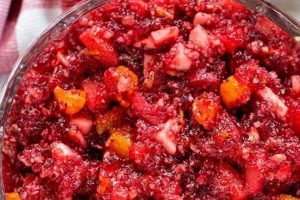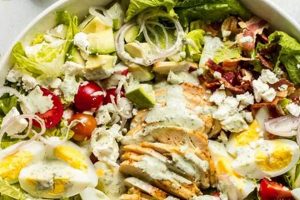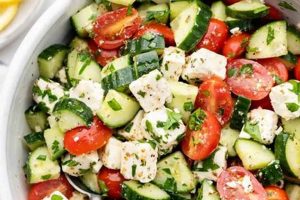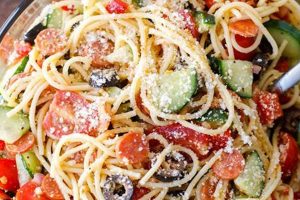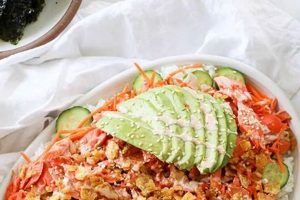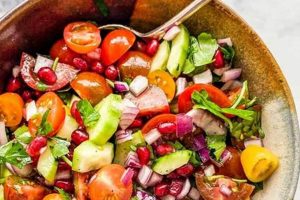Refreshing and flavorful dishes featuring chilled ingredients, often combined with light dressings, are ideal for warm-weather meals. These dishes typically include a variety of fresh produce, such as leafy greens, vegetables, fruits, and herbs, and may also incorporate proteins like grilled chicken, fish, or beans. Examples include combinations such as watermelon and feta with mint, orzo pasta with grilled vegetables and a lemon vinaigrette, or a classic Caprese with tomatoes, mozzarella, and basil.
Light, chilled meals offer a welcome respite from the heat, providing essential nutrients without weighing down the consumer. Historically, utilizing readily available seasonal produce in simple preparations has been a cornerstone of cuisines in warm climates worldwide. This focus on fresh, minimally processed ingredients aligns with contemporary dietary trends emphasizing health and wellness. Such dishes can be adapted to various dietary restrictions, such as vegetarian, vegan, or gluten-free, by substituting ingredients.
This exploration will further delve into specific categories, ingredient combinations, and preparation techniques for creating appealing and nutritious warm-weather meals. Topics to be covered include selecting the freshest produce, creating balanced flavor profiles, and exploring different cultural influences in these culinary creations.
Tips for Creating Exceptional Summer Salads
Creating a successful summer salad involves more than simply tossing ingredients together. Careful consideration of components and techniques can elevate a simple salad to a memorable culinary experience.
Tip 1: Prioritize Seasonal Produce: Selecting produce at its peak ripeness guarantees optimal flavor and nutritional value. Farmers’ markets offer excellent sources for locally grown, seasonal fruits and vegetables.
Tip 2: Embrace Variety in Textures and Flavors: Combining contrasting textures, such as crunchy lettuce, creamy avocado, and toasted nuts, adds complexity and interest. Balancing sweet, savory, acidic, and bitter flavors creates a well-rounded taste profile.
Tip 3: Dress Strategically: Dressings should complement, not overpower, the other ingredients. Light vinaigrettes, simple lemon-herb dressings, or even a drizzle of high-quality olive oil can enhance the natural flavors of the salad components. Consider adding the dressing just before serving to prevent the salad from becoming soggy.
Tip 4: Incorporate Protein Thoughtfully: Grilled chicken or fish, boiled eggs, beans, lentils, or nuts can transform a side dish into a satisfying main course. Ensure the protein is properly chilled before adding it to the salad.
Tip 5: Explore Herbs and Spices: Fresh herbs like mint, basil, dill, and chives add vibrant flavors and aromas. A pinch of spice, such as chili flakes or black pepper, can add an unexpected layer of complexity.
Tip 6: Proper Storage Maintains Freshness: Storing ingredients separately and combining them just before serving helps maintain crispness and prevents premature wilting. Prepared dressings can be stored separately in airtight containers.
By following these guidelines, one can craft refreshing and flavorful salads that highlight the best of summer’s bounty. These tips contribute to not only delicious but also visually appealing dishes perfect for any warm-weather occasion.
These tips provide a foundation for crafting exceptional summer salads, but creativity and experimentation are encouraged. The possibilities are endless.
1. Fresh, Seasonal Ingredients
The foundation of any exceptional cold summer salad lies in the utilization of fresh, seasonal ingredients. Peak-season produce offers optimal flavor, texture, and nutritional value, elevating these dishes from simple to extraordinary. This emphasis on seasonality ensures vibrant, flavorful salads that capture the essence of summer.
- Optimal Ripeness and Flavor:
Produce harvested at its peak ripeness exhibits the fullest expression of its natural flavors. Tomatoes bursting with sweetness, juicy peaches, and crisp cucumbers exemplify the difference between in-season produce and out-of-season alternatives. This vibrancy translates directly to more flavorful and enjoyable summer salads. A salad composed of peak-season tomatoes requires minimal embellishment, allowing the natural sweetness and acidity to shine.
- Enhanced Nutritional Value:
Fruits and vegetables often contain higher concentrations of vitamins and minerals when harvested in season. This nutritional boost contributes to healthier and more beneficial salads. For example, in-season berries, rich in antioxidants, contribute valuable nutrients to a summer berry salad alongside fresh spinach and a light vinaigrette.
- Support for Local Agriculture:
Choosing seasonal ingredients frequently translates to supporting local farmers and producers. Farmers’ markets offer opportunities to purchase produce directly from the source, fostering community connections and reducing the environmental impact associated with long-distance transportation. Incorporating these ingredients into summer salads directly benefits local economies and promotes sustainable agricultural practices.
- Variety and Culinary Inspiration:
The cyclical nature of seasons provides an ever-changing array of ingredients, encouraging culinary creativity and exploration. Early summer might feature salads with fresh peas and asparagus, while mid-summer highlights ripe tomatoes and corn, and late summer offers an abundance of zucchini and eggplant. This continuous evolution of available produce inspires diverse and interesting salad creations throughout the summer months.
By prioritizing fresh, seasonal ingredients, one maximizes the flavor, nutritional value, and overall enjoyment of cold summer salads. This focus on seasonality not only elevates the culinary experience but also supports local agriculture and promotes a deeper connection with the natural world. A simple salad of ripe tomatoes, fresh mozzarella, and basil, drizzled with olive oil and seasoned with salt and pepper, exemplifies the power of fresh, seasonal ingredients in creating a dish that is both delicious and healthful.
2. Balancing Flavors and Textures
A successful cold summer salad transcends mere ingredient combination; it represents a carefully constructed balance of flavors and textures. This equilibrium is crucial for a satisfying and enjoyable culinary experience. Consider the interplay of sweet and savory, crunchy and smooth, acidic and creamyeach element contributes to a dynamic and engaging sensory experience. A salad lacking textural diversity might feel monotonous, while an imbalance of flavors could be overwhelming or underwhelming.
The principle of balance manifests in various ways within cold summer salad recipes. The sweetness of ripe berries might be offset by the tangy bite of feta cheese, while the crunch of toasted nuts complements the soft texture of roasted vegetables. A bed of peppery arugula provides a contrasting base for creamy avocado and juicy grilled peaches. The interplay of these elements prevents any single flavor or texture from dominating, resulting in a harmonious and complex dish. Imagine a watermelon and feta salad: the sweetness of the watermelon is balanced by the salty feta, the watery melon by the crumbly cheese, creating a refreshing and dynamic interplay.
Understanding the importance of balancing flavors and textures provides a framework for crafting exceptional cold summer salads. It empowers culinary experimentation and informed ingredient selection. Recognizing the inherent qualities of each ingredientits taste, texture, and how it interacts with other componentsallows for the creation of dishes that are both exciting and satisfying. While challenges such as ingredient availability and personal preferences exist, the pursuit of balance remains a guiding principle in achieving culinary excellence in cold summer salad preparation. This principle extends beyond individual recipes; it informs broader culinary concepts of flavor pairing and menu design. Ultimately, a well-balanced salad embodies the art of combining contrasting elements into a unified and delicious whole.
3. Light, Complementary Dressings
The role of dressings in cold summer salad recipes is pivotal. They provide a unifying element, binding diverse ingredients while enhancing and complementing their individual flavors. Heavy, creamy dressings, while suitable for other salad types, often overwhelm the delicate flavors and textures characteristic of summer produce. Light, complementary dressings, conversely, enhance the overall composition without masking the inherent qualities of fresh, seasonal ingredients. A heavy dressing on a delicate salad of fresh greens and herbs would obscure the nuanced flavors, while a light vinaigrette would brighten and unify them.
The selection of a dressing should consider the specific ingredients and desired flavor profile. A vinaigrette with a base of citrus juice, such as lemon or lime, provides a refreshing acidity that pairs well with salads featuring fruits, vegetables, and lighter proteins like fish or chicken. For salads incorporating robust flavors, such as grilled halloumi or roasted vegetables, a slightly richer vinaigrette incorporating herbs or spices can provide depth and complexity. A classic example is a simple lemon vinaigrette on a salad of mixed greens, cucumber, and tomato; the vinaigrette brightens the flavors without overpowering them. Conversely, a heavier Caesar dressing would likely mask the subtle flavors of the fresh vegetables.
Effective dressing application further enhances the salad experience. Overdressing can lead to a soggy, unappetizing result, while underdressing leaves the salad dry and lacking cohesion. A light coating achieved through gentle tossing or drizzling just before serving ensures that each ingredient is lightly dressed without compromising texture. Emulsified dressings offer a balance of richness and lightness, clinging effectively to ingredients without being overly heavy. Understanding the nuances of dressing selection and application allows for a more sophisticated and enjoyable culinary experience, showcasing the fresh, vibrant flavors inherent in cold summer salad recipes. The careful consideration of dressings as a complementary component elevates these salads from simple assemblages of ingredients to well-composed, balanced dishes.
4. Appropriate Protein Incorporation
Protein incorporation significantly impacts the nutritional profile and satiety offered by cold summer salads. While often perceived as light, refreshing dishes primarily composed of produce, the strategic addition of protein transforms them into complete, satisfying meals. This addition not only contributes essential nutrients but also enhances textural complexity and broadens flavor profiles. Choosing suitable protein sources and employing proper preparation methods ensures these additions complement, rather than detract from, the salad’s overall character. For example, grilled chicken or fish provides lean protein, while chickpeas or lentils offer plant-based alternatives, each contributing distinct textural and flavor elements. Conversely, incorporating excessively rich or heavy proteins, such as fried meats, could overwhelm the delicate flavors and textures of fresh produce typical in these salads.
The compatibility of protein choices with the salad’s other components is paramount. Flavor pairings play a critical role: grilled salmon complements a salad with cucumbers and dill, while chickpeas harmonize with a Mediterranean-inspired salad featuring tomatoes, olives, and feta cheese. Textural considerations are equally important; the flaky texture of grilled fish contrasts pleasantly with crisp lettuce, while the firm texture of beans adds substance to a salad composed of softer ingredients. The quantity of protein incorporated also requires careful consideration. An appropriate amount ensures a balanced and satisfying meal without overshadowing the flavors and textures of the accompanying produce. A salad featuring grilled chicken as a central protein source might include a smaller portion of chicken compared to a salad where the chicken is a supplementary ingredient alongside a variety of vegetables and grains.
Appropriate protein incorporation elevates cold summer salads from side dishes to main courses, providing nutritional value and enhanced satiety. Careful consideration of protein choice, preparation method, and quantity ensures these additions enhance, rather than compromise, the salad’s intended character. Achieving this balance allows for diverse, flavorful, and nutritionally complete meals well-suited to warm-weather dining. Challenges may include ensuring even distribution of protein throughout the salad and adapting protein choices to accommodate dietary restrictions. However, the integration of appropriate protein sources remains essential for maximizing the culinary and nutritional potential of cold summer salad recipes.
5. Creative Herb and Spice Use
Strategic incorporation of herbs and spices significantly elevates cold summer salad recipes beyond basic ingredient combinations. Fresh herbs contribute vibrant aromas and nuanced flavors, transforming simple salads into complex culinary experiences. Spices, used judiciously, add depth and intrigue, further enhancing the overall sensory experience. This creative utilization of herbs and spices is essential for maximizing flavor complexity and achieving balanced flavor profiles, especially crucial in dishes emphasizing fresh, seasonal ingredients. For instance, fresh mint elevates a watermelon and feta salad, while a pinch of chili flakes adds an unexpected kick to a corn and avocado salad. The absence of such elements can result in a dish that, while perhaps nutritious, lacks vibrancy and depth of flavor.
The selection and combination of herbs and spices should reflect the other salad components and the desired overall flavor profile. Delicate herbs like dill and chives complement salads featuring lighter ingredients, such as cucumbers and fresh cheeses. More robust herbs, like rosemary and oregano, pair well with heartier salads incorporating grilled vegetables or beans. Spices offer an additional layer of complexity; a dash of smoked paprika can enhance a roasted vegetable salad, while a pinch of cumin adds warmth to a black bean and corn salad. Consider a classic Caprese salad: while delicious with just basil, the addition of fresh oregano introduces a nuanced complexity, demonstrating the transformative power of herbs. The quantity used is equally crucial; over-reliance on strong herbs or spices can overwhelm the delicate flavors of fresh produce, while insufficient amounts fail to make a noticeable impact. The goal is to achieve a harmonious balance where each element contributes to the overall flavor profile without dominating the others.
Understanding the interplay between herbs, spices, and other salad components empowers informed culinary decisions, resulting in more dynamic and flavorful cold summer salad recipes. This understanding fosters creativity and experimentation, encouraging exploration beyond traditional flavor combinations. While challenges such as seasonal herb availability and balancing flavor intensities exist, the creative use of herbs and spices remains a cornerstone of crafting exceptional summer salads. This practice aligns with broader culinary trends emphasizing fresh, flavorful, and healthful cuisine, highlighting the potential of simple ingredients to create complex and satisfying dishes. Ultimately, the judicious application of herbs and spices transforms cold summer salads from basic sustenance into memorable culinary creations.
6. Proper Storage Techniques
Proper storage techniques are essential for preserving the quality and maximizing the lifespan of fresh ingredients integral to cold summer salad recipes. Maintaining optimal ingredient freshness directly impacts the final dish’s flavor, texture, and overall appeal. Improper storage can lead to wilting, spoilage, and flavor degradation, compromising the intended culinary experience. Cause and effect relationships are evident: storing leafy greens without proper air circulation promotes premature wilting, while storing cut fruits and vegetables without proper protection accelerates oxidation and enzymatic browning. These effects significantly detract from the vibrancy and freshness essential for successful cold summer salads. For instance, improperly stored tomatoes become mealy and lose their characteristic sweetness, while limp lettuce detracts from both the visual appeal and the crisp texture desired in a salad.
The importance of proper storage techniques as a component of cold summer salad recipes extends beyond mere preservation. Strategic storage practices contribute to efficient ingredient utilization, minimizing waste and maximizing value. Separating ingredients prone to ethylene production, such as ripe bananas, from ethylene-sensitive ingredients, like leafy greens, prevents premature spoilage. Storing pre-washed and dried greens in airtight containers lined with paper towels extends their lifespan and maintains their crispness. Prepping components like chopped vegetables or cooked proteins in advance and storing them separately streamlines the salad assembly process. Practical applications of these techniques translate to less food waste, more efficient meal preparation, and ultimately, more enjoyable culinary experiences. Consider prepping ingredients for a week’s worth of salads on Sunday: storing chopped vegetables, cooked grains, and dressings separately ensures they remain fresh and readily available for quick assembly throughout the week.
Effective storage practices constitute a crucial, albeit often overlooked, aspect of successful cold summer salad preparation. Understanding the connection between proper storage and ingredient quality empowers informed decision-making, maximizing flavor, texture, and nutritional value. While challenges such as limited refrigerator space and varying optimal storage conditions for different ingredients exist, the practical significance of proper storage remains undeniable. This knowledge contributes not only to more enjoyable salads but also to broader culinary practices emphasizing resourcefulness and minimizing food waste. By prioritizing proper storage techniques, individuals can fully realize the potential of fresh, seasonal ingredients, transforming simple cold summer salads into vibrant, flavorful, and satisfying culinary creations.
Frequently Asked Questions about Cold Summer Salads
This section addresses common inquiries regarding the preparation and enjoyment of cold summer salads, offering practical guidance and clarifying potential misconceptions.
Question 1: How can wilting of leafy greens be prevented in cold summer salads?
Leafy greens wilt due to moisture loss. Storing them in airtight containers lined with paper towels helps maintain crispness. Alternatively, storing greens between damp paper towels in the refrigerator crisper drawer also effectively preserves freshness. Washing greens only when ready to use further minimizes moisture exposure and reduces wilting.
Question 2: What are effective strategies for preventing salads from becoming watery?
Excess moisture accumulation can be minimized by thoroughly drying ingredients after washing, especially leafy greens and vegetables with high water content, such as cucumbers and tomatoes. Salting certain vegetables, like cucumbers and tomatoes, and allowing them to drain before adding them to the salad also helps reduce excess moisture. Adding dressings immediately before serving further prevents the salad from becoming watery.
Question 3: What protein sources are best suited for cold summer salads?
Suitable protein choices complement the salad’s other components. Grilled chicken or fish, hard-boiled eggs, beans, lentils, and nuts offer excellent protein sources. Consider flavor and texture compatibility when selecting proteins. For example, grilled chicken pairs well with robust flavors, while flaked fish complements lighter salads.
Question 4: How can one make a cold summer salad a complete meal?
Incorporating a variety of ingredients from different food groups transforms a simple salad into a nutritionally complete meal. Including protein, healthy fats, and complex carbohydrates, alongside fresh produce, ensures a balanced and satisfying meal. Examples include adding grilled chicken or fish for protein, avocado for healthy fats, and quinoa or barley for complex carbohydrates.
Question 5: What dressings are most appropriate for cold summer salads?
Light and flavorful dressings enhance the fresh ingredients without overpowering them. Vinaigrettes based on citrus juices or light vinegars, combined with high-quality olive oil, are ideal choices. Simple herb-based dressings, or even a drizzle of olive oil and a sprinkle of sea salt, can also complement summer salads beautifully. Avoid heavy, creamy dressings that can mask the delicate flavors of fresh produce.
Question 6: How can food waste be minimized when preparing cold summer salads?
Proper storage is key to minimizing waste. Store ingredients separately and combine them only when ready to serve. Utilize airtight containers for storing prepared components and dressings. Planning meals in advance and purchasing only the necessary quantities of ingredients also contribute to reducing food waste.
By understanding these key aspects of cold summer salad preparation, one can create delicious, healthy, and satisfying meals ideal for warm-weather enjoyment. Prioritizing fresh ingredients, balanced flavors, and appropriate storage techniques contributes to optimizing both culinary satisfaction and nutritional value.
The following section will explore specific cold summer salad recipes showcasing the principles discussed throughout this article.
Cold Summer Salad Recipes
This exploration has examined the multifaceted nature of cold summer salad recipes, emphasizing the critical elements that contribute to successful outcomes. From the foundational importance of fresh, seasonal ingredients to the nuanced interplay of flavors, textures, and complementary dressings, each component contributes to a harmonious and satisfying culinary experience. Proper protein incorporation elevates these dishes from simple accompaniments to complete, nutritious meals, while the judicious use of herbs and spices enhances flavor complexity. Finally, proper storage techniques ensure ingredient longevity and maximize freshness, preserving the intended vibrancy and taste.
Cold summer salad recipes represent more than a mere culinary category; they embody a celebration of seasonality, freshness, and culinary creativity. The adaptability of these dishes allows for endless variation, accommodating diverse dietary preferences and culinary traditions. Continued exploration of ingredient combinations, flavor profiles, and presentation styles promises an evolving landscape of culinary possibilities, ensuring the enduring appeal of cold summer salads as a refreshing and invigorating element of warm-weather dining.

